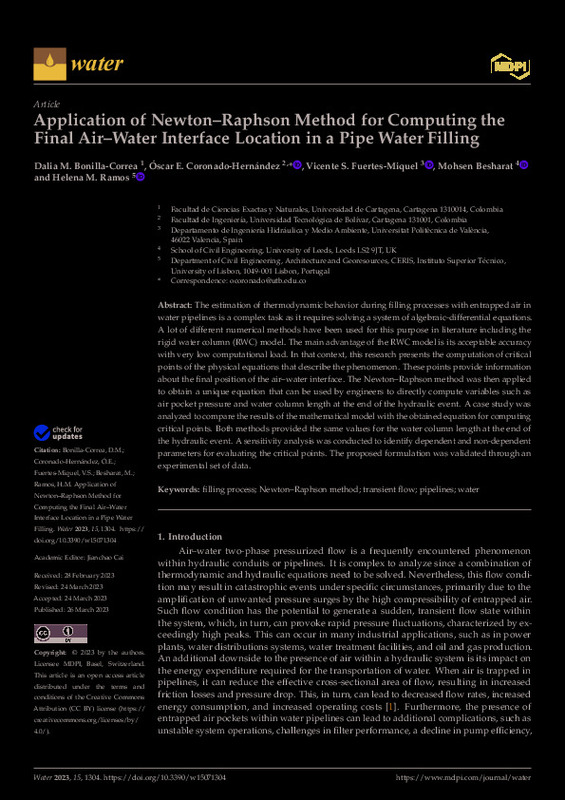JavaScript is disabled for your browser. Some features of this site may not work without it.
Buscar en RiuNet
Listar
Mi cuenta
Estadísticas
Ayuda RiuNet
Admin. UPV
Application of Newton-Raphson method for computing the final air-water interface location in a pipe water filling
Mostrar el registro sencillo del ítem
Ficheros en el ítem
| dc.contributor.author | Bonilla-Correa, Dalia M.
|
es_ES |
| dc.contributor.author | Coronado-Hernández, Oscar Enrique
|
es_ES |
| dc.contributor.author | Fuertes-Miquel, Vicente S.
|
es_ES |
| dc.contributor.author | Besharat, Mohsen
|
es_ES |
| dc.contributor.author | Ramos, Helena M.
|
es_ES |
| dc.date.accessioned | 2024-03-06T19:01:11Z | |
| dc.date.available | 2024-03-06T19:01:11Z | |
| dc.date.issued | 2023-04 | es_ES |
| dc.identifier.issn | 2073-4441 | es_ES |
| dc.identifier.uri | http://hdl.handle.net/10251/202944 | |
| dc.description.abstract | [EN] The estimation of thermodynamic behavior during filling processes with entrapped air in water pipelines is a complex task as it requires solving a system of algebraic-differential equations. A lot of different numerical methods have been used for this purpose in literature including the rigid water column (RWC) model. The main advantage of the RWC model is its acceptable accuracy with very low computational load. In that context, this research presents the computation of critical points of the physical equations that describe the phenomenon. These points provide information about the final position of the air¿water interface. The Newton¿Raphson method was then applied to obtain a unique equation that can be used by engineers to directly compute variables such as air pocket pressure and water column length at the end of the hydraulic event. A case study was analyzed to compare the results of the mathematical model with the obtained equation for computing critical points. Both methods provided the same values for the water column length at the end of the hydraulic event. A sensitivity analysis was conducted to identify dependent and non-dependent parameters for evaluating the critical points. The proposed formulation was validated through an experimental set of data. | es_ES |
| dc.language | Inglés | es_ES |
| dc.publisher | MDPI AG | es_ES |
| dc.relation.ispartof | Water | es_ES |
| dc.rights | Reconocimiento (by) | es_ES |
| dc.subject | Filling process | es_ES |
| dc.subject | Newton-Raphson method | es_ES |
| dc.subject | Transient flow | es_ES |
| dc.subject | Pipelines | es_ES |
| dc.subject | Water | es_ES |
| dc.subject.classification | MECANICA DE FLUIDOS | es_ES |
| dc.title | Application of Newton-Raphson method for computing the final air-water interface location in a pipe water filling | es_ES |
| dc.type | Artículo | es_ES |
| dc.identifier.doi | 10.3390/w15071304 | es_ES |
| dc.rights.accessRights | Abierto | es_ES |
| dc.contributor.affiliation | Universitat Politècnica de València. Escuela Técnica Superior de Ingenieros Industriales - Escola Tècnica Superior d'Enginyers Industrials | es_ES |
| dc.description.bibliographicCitation | Bonilla-Correa, DM.; Coronado-Hernández, OE.; Fuertes-Miquel, VS.; Besharat, M.; Ramos, HM. (2023). Application of Newton-Raphson method for computing the final air-water interface location in a pipe water filling. Water. 15(7). https://doi.org/10.3390/w15071304 | es_ES |
| dc.description.accrualMethod | S | es_ES |
| dc.relation.publisherversion | https://doi.org/10.3390/w15071304 | es_ES |
| dc.type.version | info:eu-repo/semantics/publishedVersion | es_ES |
| dc.description.volume | 15 | es_ES |
| dc.description.issue | 7 | es_ES |
| dc.relation.pasarela | S\489518 | es_ES |








